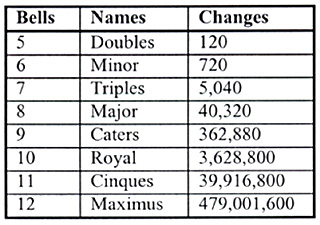Bell ringing is a highly developed art in the United Kingdom. Ringers ring the heavy bells in church towers to produce orderly sequences of notes. Each bell, when struck, produces a different note. The sequence varies at each pull of the bell ropes. This type of bell ringing is known as change ringing. Bell ringers need skill to keep their bells ringing in the sequence they have chosen. Bell ringing is also known as campanology. The word comes from a Latin word meaning bell and a Greek word meaning science.
The art of ringing.
A set of bells hung in a tower is known as a ring of bells. Nearly all rings of bells in the United Kingdom hang in church towers. The bells hang in a framework. Each bell is fixed at its head to a block called a headstock. The headstock is, in turn, attached to a large grooved wheel and an upright wooden bar called a stay. A rope passes over the groove in the wheel and hangs down to the ringing chamber below.
To chime a bell, the ringer pulls the rope gently so that the bell swings until its clapper strikes. A bell makes a pleasant and tranquil sound when it is chimed. But a bell produces a full, rich tone only when it is rung.
To ring a bell, the ringer must first raise the bell until it is propped upside down. The ringer does so by making repeated pulls on the rope until the bell is swinging almost full circle. As it reaches an upright position, the stay touches a sliding bar or a curved groove, and the bell is set and ready for ringing.
Before a ringing performance, the ringers decide on the sequence of changes they will ring. Change ringing is based on the rule that a bell may change places only with the bell striking before it or after it. On this plan, it is possible for the bells to move in ordered paths and produce a succession of changes.
Each change rung on any given number of bells has a distinguishing name. The following table sets out these names and the totals of the changes that it is possible to ring on a given number of bells.

From all the possible changes available, the ringers choose one of the many series of changes that past bell ringers have established. Each series is known as a method, and each method has its own name. For example, one method is known as Plain Bob. Changes rung on six bells in the Plain Bob method are known as Plain Bob Minor. Changes rung on 10 bells in the same method are known as Plain Bob Royal. If a performance is completed in less than 5,000 changes, it is known as a touch. A performance completed in 5,000 or more changes is known as a peal. Early in 1964, eight young men rang all the 40,320 possible changes on eight bells at a bell foundry in Loughborough, Leicestershire, England. They rang without pause for 17 hours 58 minutes, the greatest bell ringing achievement on record.
History.
Change ringing developed in the early 1600’s. It developed as a result of the discovery that a ringer could control the movement of a bell more accurately when the bell was attached to a full wheel. By the mid-1600’s, bell ringing was a popular pastime. Ringers formed guilds and associations for the practice of change ringing. In 1668, Fabian Stedman, an English printer, published a textbook on the art of change ringing.
Until the late 1800’s, bell ringing remained a pastime practiced in churches, but with little connection with religious practices. But, in the 1880’s, many bell-ringing associations led a reform to associate bell ringing more closely with the worship of God. Sir Arthur Heywood, an English baronet, founded the Central Council of Church Bell Ringers. He presided over the council’s first meeting in 1891.
